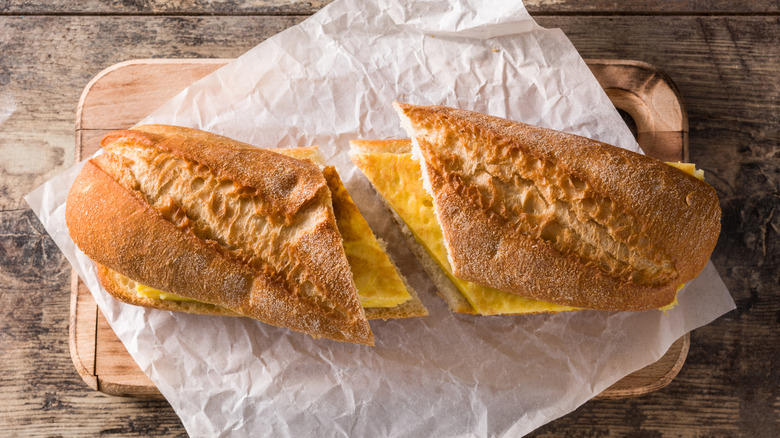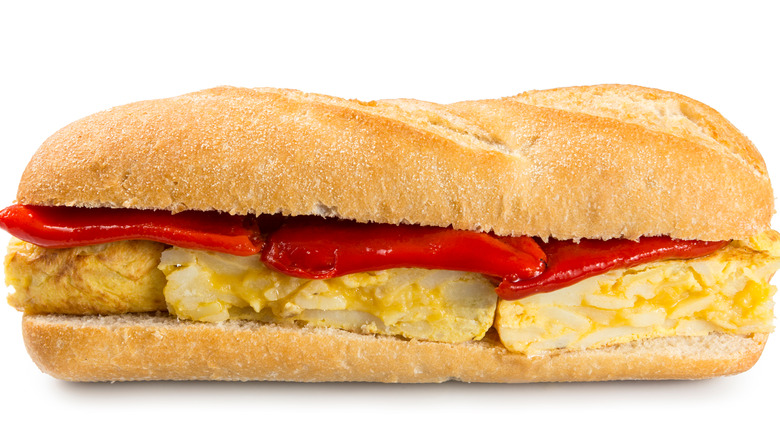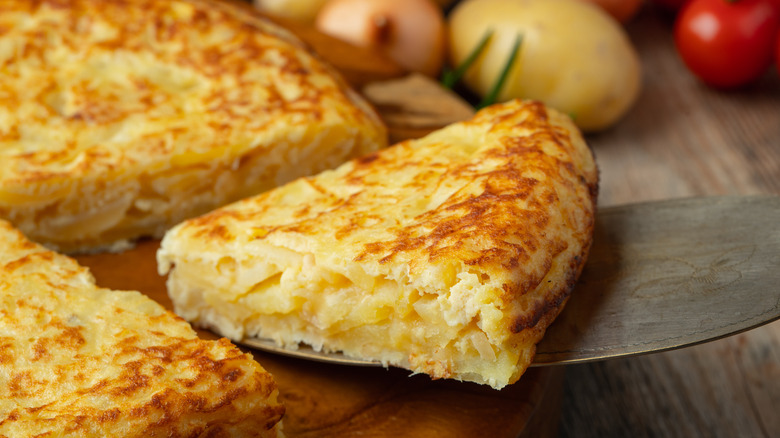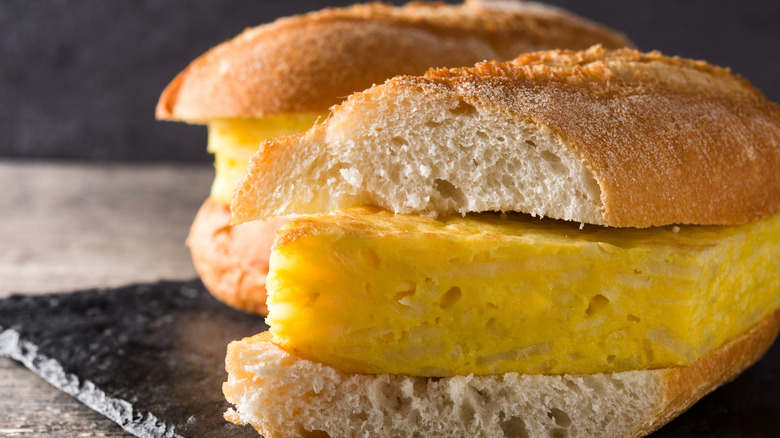Spain's Bocadillo De Tortilla Is The Ultimate Comfort Sandwich
Few meals carry the same warm glow as a sandwich. Whether a throwback to childhood with a PB & J or a perenially popular grilled cheese, assembling only a few components between two slices of bread yields something grander than the sum of its parts. The quintessence of a good sandwich is an interplay of textures and flavors — think the crispy saltiness of bacon balanced with the juiciness of tomatoes in a BLT. And as a highly open-ended dish consumed globally for centuries, there are a dizzying variety of interpretations. The Japanese pork katsu, crispy breaded port atop delightfully fluffy white bread, is a celebrated classic. Or there are the increasingly popularized Trinidadian doubles — crispy flatbreads topped with chickpea curry (via Thrillist).
The rules aren't strict, and unlike other dishes, carb-on-carb sandwiches are encouraged. So let's dive into a Spanish sandwich that blends eggs, potatoes, and bread into something special. Meet the bocadillo de tortilla.
A bocadillo de tortilla consists of a Spanish frittata sandwhiched in a baguette
This comfort food centers on a tortilla — but not the Mexican kind. Instead, it's all about a potato and egg frittata, sometimes further specified as a tortilla española. This delicious Spanish classic is frequently served as a snack on its own. However, place it in between two slices of baguette, and you have a bocadillo de tortilla. While a sauce, like ketchup, mayo, or hot sauce, may make an appearance, it's certainly not essential, reports The Takeout.
A comforting creation, this dish belongs to a greater classification of Spanish sandwiches known as bocadillos or bocatas. Favoring simplicity, they contain only one or two ingredients enclosed in a baguette, per Sandwich Tribunal. Spaniards prefer more uncomplicated sandwiches since they're more of a snack — eating five times a day is common in the Iberian nation. As a result, having a few high-quality ingredients simplifies eating standing up at a bar or on the go, notes Takeaway. And with light, fluffy eggs, filling potatoes, and crispy baguette, what else is necessary?
How a bocadillo de tortilla is prepared
Making a bocadillo de tortilla is essentially cooking a tortilla, then finding a suitable crispy loaf of baguette as a vehicle. It all starts with a large amount of olive oil, heated in a pan to fry the potatoes and sometimes onions. Once the potatoes are cooked through and crispy, the mixture is drained and combined with eggs. The frittata is then fried, one side at a time, using a plate to flip. After the desired browning on the outside, it's cooled, sliced into sections, and sandwiched between two pieces of baguette, per Serious Eats.
Since cooking the potatoes for the omelet can take a while, Food 52 offers a quicker alternative with a microwave. Throw the peeled and sliced spuds, wrapped in a wet paper towel, into the microwave for about three minutes. To attain the olive oil-induced crispness, heat a pan in the oven, and then finish cooking the potatoes without a stovetop. In this rendition, the sandwich also comes with tomatoes and garlic aioli for some added moisture; just keep in mind this will come at the price of added messiness.
History of bocadillo de tortilla and where to find it
The origins of the tortilla, and therefore the sandwich, are murky. The only certainty is that the dish is less than 500 years old since potatoes were introduced after the discovery of the New World. A few legends circulate around the birth of the omelet — typically pointing towards the Northeast provinces of Navarra or the Basque country in the 18th-19th century, notes Socarrat.
Now, the sandwich is a staple across all of Spain, with historic bars and taverns purveyors of the best interpretations. In Barcelona, Quimet de Horta is such a celebrated institution with a delicious bocadillo de tortilla, per Time Out. Alternatively, head to foodie hot spot San Sebastián, and try one at Bar Juantxo, where the potato omelet is prepared right before serving. A rarity in Spain, the bar also offers optional toppings like peppers, cheese, and ham, via Skyscanner. And if a search fails, simply pop into a local Spanish cafe or bar — odds are they'll have a bocadillo to offer, per Takeaway.



